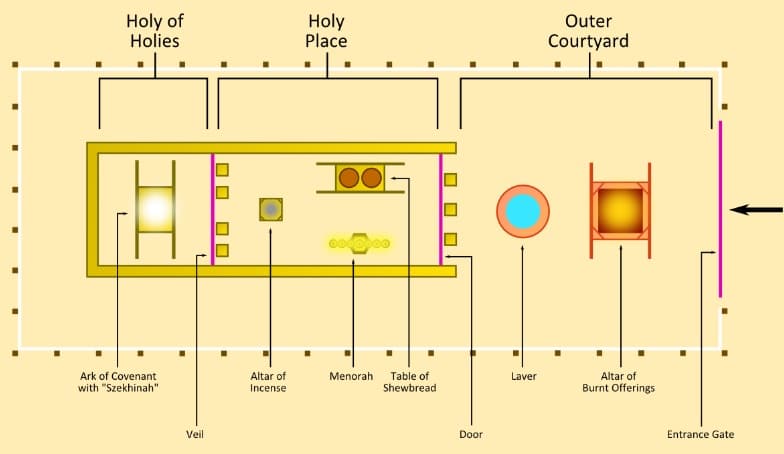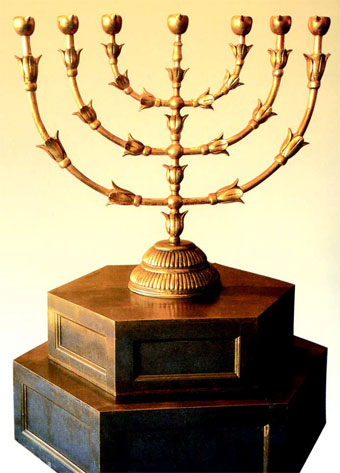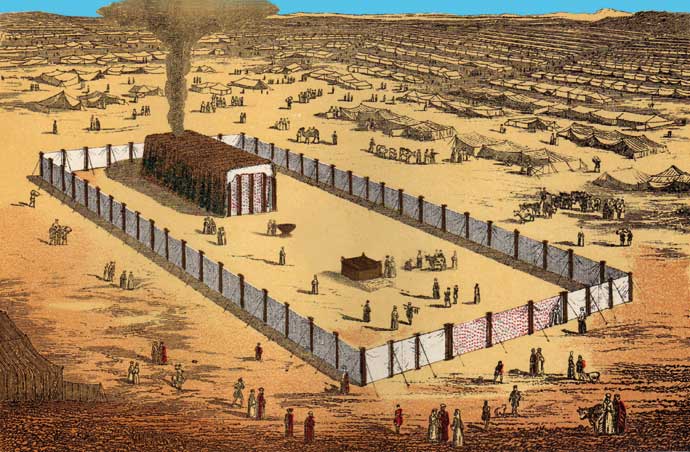We’ve arrived at Lesson 10 and we are going to enter the tabernacle proper. Keep in mind, for you to enter, you must not just be a ‘regular’ Israelite; you absolutely must be a priest of the tribe of Levi to enter in. When you get to the New Testament, you understand that through faith in the Lord Jesus Christ, you have become a believer-priest.
You … are being built up a spiritual house, a holy priesthood, to offer up spiritual sacrifices acceptable to God through Jesus Christ. (1Peter 2:5 NKJV) You can also do some thinking about Hebrews 10:19-22. The moment you trusted Christ, you were brought inside and ‘spiritually’ you are there 24/7. As a priest today, what are the spiritual sacrifices you can offer up?
Today, I came across the list below – which simply contrasts the ancient tabernacle and all its practises with what we have in Christ as described in the Epistle to the Hebrews. Here it is:
- Shadows replaced by Substance,
- Ritual replaced by Reality,
- Pictures replaced by the Person,
- Covering of sin replaced by Cleansing of sin,
- Remembrance of sins every year replaced by Removal of sins,
- Repetition of the sacrifices replaced by Remission of sins,
- Perpetual offerings replaced by a Perfect Offering,
- Many Priests standing replaced by One Priest sitting (1)
Having said all that, now let’s go inside and look around.
Everything was gold inside the holy place – the table of shewbread on the right side (north); the altar of incense was positioned in front of the thick curtain/veil that separated the holy place from the holy of holies. And then, on the left side (south) was the most unique and beautiful golden lampstand.

We are about to study the strikingly beautiful lampstand – the original menorah. Perhaps you have seen menorahs in home windows or as a centrepiece on the dining-room table of your Jewish friend – usually in the same month, you see Christmas lights. They are celebrating an unrelated 8-day Jewish holiday – unrelated to Christmas. The number of candles lit has changed from the original Tabernacle Lampstand, but there are still similarities.
They are celebrating an unrelated 8-day Jewish holiday – unrelated to Christmas. The number of candles lit has changed from the original Tabernacle Lampstand, but there are still similarities.
The original lampstand must have been incredibly beautiful and definitely of great value. But stop for a second and ask yourself: why don’t Christians have beautifully decorated spiritual symbols and objects that wow us today and help us feel that we belong to something very special? Answer: we have Christ, who eclipses anything that could ever be made by human hands. They had the shadows. We have the substance – the reality. He is the total and ultimate fulfillment of everything we are studying in the ancient tabernacle. That’s what the Epistle to the Hebrews is all about.
Here is the first reference to the lampstand:
“Then you shall make a lampstand of pure gold. The lampstand and its base and its shaft are to be made of hammered work; its cups, its bulbs and its flowers shall be of one piece with it. “Six branches shall go out from its sides; three branches of the lampstand from its one side and three branches of the lampstand from its other side… mount its lamps so as to shed light on the space in front of it… It shall be made from a talent (90 pounds or 40 kilograms) of pure gold, with all these utensils. See that you make them after the pattern for them, which was shown to you on the mountain. Exodus 25:31-32,37,39-40 NASB

Back in Lesson 8, we learned that the bronze laver had no measurements whatsoever. That’s almost the case with the lampstand – except the weight measurement is given. Think of the unfathomable greatness of Christ in whom all the fullness of the Godhead dwelled. (Colossians 2:9)
 In today’s currency, 40 kg of gold is worth at least CA$ 2.2 million as of September 2016. A very pricey light fixture for a room! But of infinitely greater value is the One whom this light fixture represents.
In today’s currency, 40 kg of gold is worth at least CA$ 2.2 million as of September 2016. A very pricey light fixture for a room! But of infinitely greater value is the One whom this light fixture represents.
“The gold in the lampstand typified the deity of Christ, the divine Son of God, who stepped across the galaxies of the universe and became a man. He was pure in His humanity, having neither spot nor blemish (1 Peter 1:19), but it was His deity that sustained His Perfect Humanity.” (2)
Not only was the lampstand solid gold (not gold plating) – but it was one single unit. It wasn’t modular, with gold branches being attached to the center stem. No, the Bible is very specific. It was “beaten out” and crafted, curved and shaped without any joints or breaks. Imagine the almond blossom cups, the knobs and the flowers all being crafted as a part of the single piece – without being attached later to the branches.
Our Lord Jesus Christ was beaten and bruised. Bow your head just now and think upon the pure gold and how it was beaten.
You can follow the light motif throughout the Bible. It’s a great study. As we study ‘light’ just within the bounds of the current subject of the tabernacle – there are three sources of light: 1. out in the courtyard, there was the natural light of sunrays and moonbeams for all to see and appreciate. 2. Inside the Holy Place, where we are now, the light came from the lampstand, and it was only appreciated by the priests because only they went in there. 3. Finally, in an upcoming lesson, inside the Holy of Holies, we will learn about the ‘glory of God’ that gave the brightness there – the Shekinah light, which only the High Priest was privileged to experience once a year.
The light shining from the lampstand could hardly symbolize Christ being the ‘light of the world.’ Why? Because the lampstand light was only appreciated by a select few; its radiant beauty was hidden from the masses of Israelites. Dr. A. J. Higgins suggests that this light was for the priestly family as they moved and worked inside the sanctuary. Christ is our light for fellowship with God, and in Colossians 3:3, we are told that our life, as Christians, is ‘hidden’ with Christ in God. Daily, as believers, we can appreciate the radiant beauty and glow of Christ in our lives. What communion and fellowship!
 Not only did the lampstand illuminate the Holy Place / Room, but it seems from Exodus 25:37 that it was to be constructed in such a way that the light would also light up the beauty of the lampstand itself. In the sanctuary, we don’t just enjoy the light of Christ in the fellowship of our service, but we also get to see the beauty of our risen and living Christ Himself.
Not only did the lampstand illuminate the Holy Place / Room, but it seems from Exodus 25:37 that it was to be constructed in such a way that the light would also light up the beauty of the lampstand itself. In the sanctuary, we don’t just enjoy the light of Christ in the fellowship of our service, but we also get to see the beauty of our risen and living Christ Himself.
If you read the verses carefully, you will notice that not only do we not know how wide or how high the lampstand was, there’s no mention of its ‘foot’ or ‘base’ – what it stood on. It could possibly suggest that with the ‘connection’ to the ground/earth not being mentioned, we are reminded that our sphere of fellowship is spiritual in the heavenlies. (Ephesians 1:3)
Finally, what’s with the knops (buds), almonds and flower decorations on the lampstand? L-I-F-E. Look at the artist’s drawing of the lampstand again, and perhaps you can see a vague resemblance to a tree. Buds, flowers, and almonds suggest life in its development and progress.
“The enjoyment of a risen glorified Christ is the food [for spiritual growth] of those who enjoy sanctuary experience. We set our affection, our minds on ‘things above.’” (3)
Sources:
- http://truthandtidings.com/1998/10/when-thy-son-asketh-thee-concerning-the-priesthood-of-believers/ Author: Lloyd Cain
- The Tabernacle, David M. Levy, p.38
- Dr. A.J. Higgins, Monday Meditations

